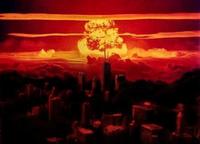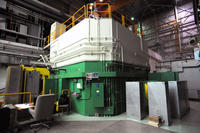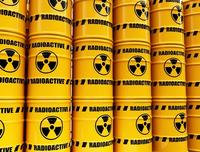-
Chemical, physical traits of post-nuclear detonation fallout identified
Post-detonation nuclear forensics relies on advanced analytical techniques and an understanding of the physio-chemical processes associated with a nuclear detonation to identify the device type and the source of the nuclear material in the device. Researchers have begun to develop a technique that provides a practical approach for looking into the complex physical and chemical processes that occur during fallout formation following a nuclear detonation.
-
-
The basis for a permanent deal: deep, verifiable changes to Iran’s nuclear program
A new study says that only broad and verifiable changes to Iran’s current nuclear program could serve as a basis for a permanent nuclear deal between Iran and the international community. Among the changes: reducing the number of Iran’s uranium-enrichment centrifuges from the current 19,500 to no more than 4,000, and limiting Iran to one enrichment site; converting the heavy-water reactor being built in Araq to a light-water reactor fueled by low-enriched uranium; and imposing a tight, intrusive inspection regime for at least twenty years.
-
-
Service lives of European nuclear power stations to be extended
Germany has decided to abandon nuclear energy – in what the Germans call Energiewende (energy turnaround) – but new nuclear power stations are being built on all sides of Germany and service lives for existing facilities on the territory of Germany’s neighbors are being extended. German nuclear scientists should thus continue to be involved in assessing the safety of the nuclear power stations in neighboring countries, especially so since the EU has launched its LONGLIFE project, which aims to extend the service life of existing reactors from forty to sixty or even eighty years.
-
-
NRC: storing spent nuclear fuel in cooling pools is safe
The nuclear reactors now in service in the United States were built with the assumption that the spent fuel would be removed from nuclear the facilities after a few years, but because the government has failed to provide a centralized place to store the spent fuel, utility companies have had to store an ever-growing quantity of it in spent fuel pools on the grounds of the facilities. Scientists argue that it would be safer to move some of the spent fuel into giant steel and concrete casks, where it can be stored dry, with no reliance on water, pumps, or filters to keep them cool. The nuclear industry and the NRC do not agree.
-
-
Surviving a nuclear explosion in your city

During the cold war, scientists modeled every imaginable consequence of a nuclear explosion. Michael Dillon, a Lawrence Livermore Lab mathematician, found a gap in the sheltering strategies for people far enough from ground zero to survive the initial blast but close enough to face deadly radioactive fallout. Dillon’s model’s addresses the most vulnerable people, those who found shelter from the blast in lightweight buildings, or buildings lacking a basement (these buildings are more easily penetrated by deadly radioactive dust). His recommendations: if adequate shelter is fifteen minutes away, people should remain in their initial, poor-quality shelter no longer than thirty minutes after detonation. If the better shelter is only five minutes away, however, individuals should move there immediately, leaving the closer but unsafe buildings altogether.
-
-
India-Pakistan nuclear war would lead to world-wide famine: study
An India-Pakistan nuclear war may see the use of about 100 Hiroshima-size bombs – about half of India and Pakistan’s nuclear arsenals. A new study says that a nuclear exchange on such a scale would “probably cause the end (of) modern industrial civilization as we know it” by subjecting about two billion people to the risk of starvation, and causing massive economic and social disruptions far away from the theater of war. Among the consequences of a nuclear exchange: Chinese winter wheat production could decline by 50 percent during the first year and by more than 30 percent over ten years; there would be a 21 percent decline in Chinese middle-season rice production during the first four years and an average 10 percent decline in the following six years; corn and soybean production in the United States would decline by 10 percent on average for ten years.
-
-
Stolen nuclear material found intact in Mexico
Mexican police yesterday said they have found a truck, a white 2007 Volkswagen cargo vehicle, which was stolen Monday by thieves who apparently were not aware that it was carrying toxic radioactive medical material from a hospital to a disposal site. The cobalt-60 the truck was carrying could be used to build a “dirty bomb.” The IAEA said that more than 100 incidents of thefts and other unauthorized activities involving nuclear and radioactive material are reported to the agency annually.
-
-
Yasser Arafat was not poisoned: French investigators

French scientific and medical experts rule out possibility that Palestinian leader was poisoned by radioactive polonium-210. A Russian medical team examining tissue samples taken from Arafat’s body reached the same conclusion three months ago. The conclusions of a Swiss medical team were more ambiguous. Leaders of the Palestinian Authority began accusing Israel of poisoning Arafat even before he died, as his health was rapidly declining. Israel has consistently denied the accusation, describing it as “unreasonable and unsupported by facts.”
-
-
Arafat may have been poisoned, but what is polonium?

A Swiss forensic report of the exhumed remains of ex-Palestinian leader Yasser Arafat last month suggested polonium poisoning may have been the cause of death – but what is polonium, and why is it so deadly? Polonium is a highly radioactive heavy metal. It is arguably the most lethal known material. Although it has some minor industrial uses it is best known for links with possible assassinations. It is also used to produce neutrons in the core of nuclear weapons. Polonium is element 84 in the periodic table, and all of its isotopes are radioactive. Their half-lives vary between a few millionths of a second to 103 years.
-
-
Uranium, plutonium, heavy water … why Iran’s nuclear deal matters
The agreement reached with Iran will limit enrichment to 5 percent U-235 and allow International Atomic Energy Agency (IAEA) inspectors regular visits (even daily) to their facilities. The inspectors can easily determine the ratios of U-235 and Pu-239 in the input fuel and waste streams via the characteristic radiation signatures of the isotopes involved. These stand out like a sore thumb to their instruments. In addition, the IAEA will measure the amount of U-235 employed at each facility to determine if any of the uranium is diverted to undisclosed locations. While this arrangement is operating it is highly unlikely that Iran will be able to build nuclear weapons.
-
-
The interim agreement between the P5+1 and Iran: the details
The P5+1 countries (the United States, United Kingdom, Germany, France, Russia, and China, facilitated by the European Union) have been engaged in negotiations with Iran in an effort to reach a verifiable diplomatic resolution which would prevent Iran from obtaining a nuclear weapon. On Sunday, the P5+1 and Iran reached a set of initial understandings which halts, at least temporarily, the progress of Iran’s nuclear program and rolls it back in key respects. In return, for Iran’s concessions, and as part of this initial step, the P5+1 will provide what the agreement describes as “limited, temporary, targeted, and reversible” relief to Iran.
-
-
Detecting radioactive material in nuclear waste water
As the Fukushima crisis continues to remind the world of the potential dangers of nuclear disposal and unforeseen accidents, scientists are reporting progress toward a new way to detect the radioactive materials uranium and plutonium in waste water.
-
-
New drone to monitor radiation following nuclear disasters

Researchers have unveiled a large semi-autonomous drone called the ARM system which could be used to provide visual and thermal monitoring of radiation after a release of nuclear material. The system was developed in response to requirements for radiation monitoring in event of the release of radioactive materials.
-
-
DOE to resume transient testing of nuclear fuels and materials

Transient testing of nuclear fuel involves placing fuel or material into the core of a nuclear reactor and subjecting it to short bursts of intense, high-power radiation in order to analyze the effects of the radiation. The Idaho National Laboratory (INL) Transient Reactor Test Facility began operating on 23 February 1959 and was a principal reactor safety testing facility in the United States for thirty-five years. The U.S. Department of Energy invites the public to read and comment on a draft environmental assessment it has prepared for a proposal to resume transient testing of nuclear fuels and materials.
-
-
Reducing volume of nuclear waste by 90 percent possible

Engineers have developed a way significantly to reduce the volume of some higher activity wastes, which will reduce the cost of interim storage and final disposal. The researchers have shown that mixing plutonium-contaminated waste with blast furnace slag and turning it into glass reduces its volume by 85-95 percent. It also effectively locks in the radioactive plutonium, creating a stable end product.
-
- All
- Regional
- Water
- Biometrics
- Borders/Immig
- Business
- Cybersecurity
- Detection
- Disasters
- Government
- Infrastructure
- International
- Public health
- Public Safety
- Communication interoperabillity
- Emergency services
- Emergency medical services
- Fire
- First response
- IEDs
- Law Enforcement
- Law Enforcement Technology
- Military technology
- Nonlethal weapons
- Nuclear weapons
- Personal protection equipment
- Police
- Notification /alert systems
- Situational awareness
- Weapons systems
- Sci-Tech
- Sector Reports
- Surveillance
- Transportation
Advertising & Marketing: advertise@newswirepubs.com
Editorial: editor@newswirepubs.com
General: info@newswirepubs.com
2010-2011 © News Wire Publications, LLC News Wire Publications, LLC
220 Old Country Road | Suite 200 | Mineola | New York | 11501
Permissions and Policies
Editorial: editor@newswirepubs.com
General: info@newswirepubs.com
2010-2011 © News Wire Publications, LLC News Wire Publications, LLC
220 Old Country Road | Suite 200 | Mineola | New York | 11501
Permissions and Policies
